Producing Post Cereal Football Cards*
Krakoski vs. Guglielmi, Shofner vs. Nolan and Weber
Why is card #193 Joe Krakoski much more in demand than #158 Ralph Guglielmi when both short print cards were featured on Post Tens and Grape Nuts Flakes 16 oz. products? The same question can be asked of #28 Del Shofner (Raisin Bran 10 oz. and Grape Nuts Flakes 16 oz.) in relation to both #25 Dick Nolan and #44 Chuck Weber. The answer is found in the details of the card production process. (Yes, this is well worth the time it will take to go through this page!)
Designing a Post cereal card
In his book "CARDBOARD, CRUNCH, MILK & SCISSORS," Post cereal collector and author Dan Mabey documented the steps that Post company employees undertook to produce baseball cards for the 1961 promotion. Processes included photography, writing biographies, creating artwork used to produce the cards and printing the actual boxes.
Information about the photography of the 1962 Post cereal football promotion is detailed on this website under the Photographer menu. If Post followed the same script as for the 1961 baseball promotion, members of the company's art department were responsible for writing the player biographies. According to "CARDBOARD, CRUNCH, MILK & SCISSORS," card art was handled by Post's art department. Whether this was still true for the 1962 football promotion isn't known, but Traverse-Eddy Graphic Design of Kalamazoo, Michigan was responsible for producing the card art for the 1963 Post and Jell-O baseball promotions. It appears that somewhere along the line Post outsourced the artwork.
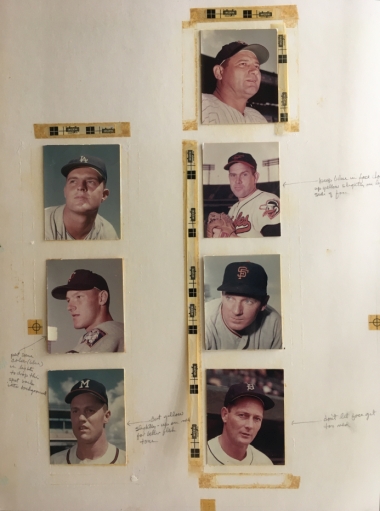 |
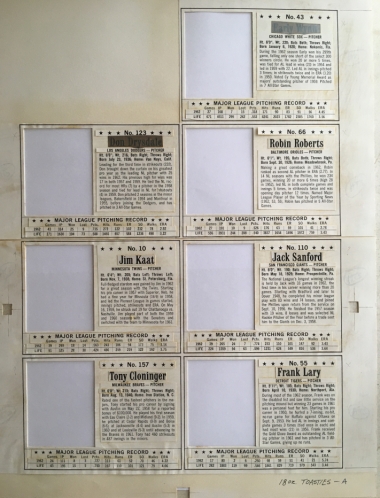 |
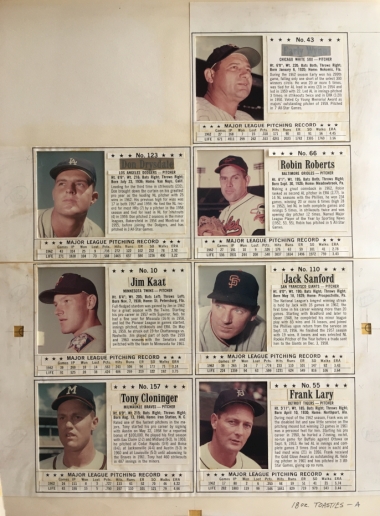 |
|---|---|---|
| Lower photo layer | Upper biographic layer | Overlay |
Card art was a literal cut and paste production. A blank white rectangular sheet of cardboard was used as the foundation upon which photographs and parts of the card were pasted using contact cement—the tool of the day. The foundation sheet was about twice as thick as a regular football card and larger than the finished panel. There wasn't a standard size or fixed ratio to the size of the finished card art panel as these pasteboards were of varying dimensions. Cards on the art panels were 3¾" x 5¼" which is 150% longer and wider than the finished card. Player photographs were cut to size and glued in proper position on the foundation pasteboard. A layer of lightweight white card stock was glued on top of the foundation to create the background for cards and was hinged at the top of the foundation pasteboard with tape so the art department could flip up a layer at a time to make card piece placements, adjustments and notes.
The next layer up was even thinner paper stock that served as the base for the individual card pieces cut from thin paper stock—biography block, post logo, card number in the football, player name, team and position, college, date of birth and current hometown information. Layout lines were drawn to demarcate sides, corners and midpoints. This layer was also hinged at the top. Card pieces were all pasted in exact position. The back panel header was created and laid in place. Panels for the box front, sides, top and bottom flaps were also created using the cut and paste method with the same 150% scale as on the cards. The back panel artwork could be put in place and the image of a whole flat box had been created. The flat box artwork was then "camera ready" to be photographed. The other back panel artworks for each particular cereal product would be put in place and photographed.
When all of the artwork flat box images for a particular cereal product were photographed, they were sent to a rotogravure shop to create an etched cylinder. The cylinder etching for each cereal product included all of the back panels for that product. 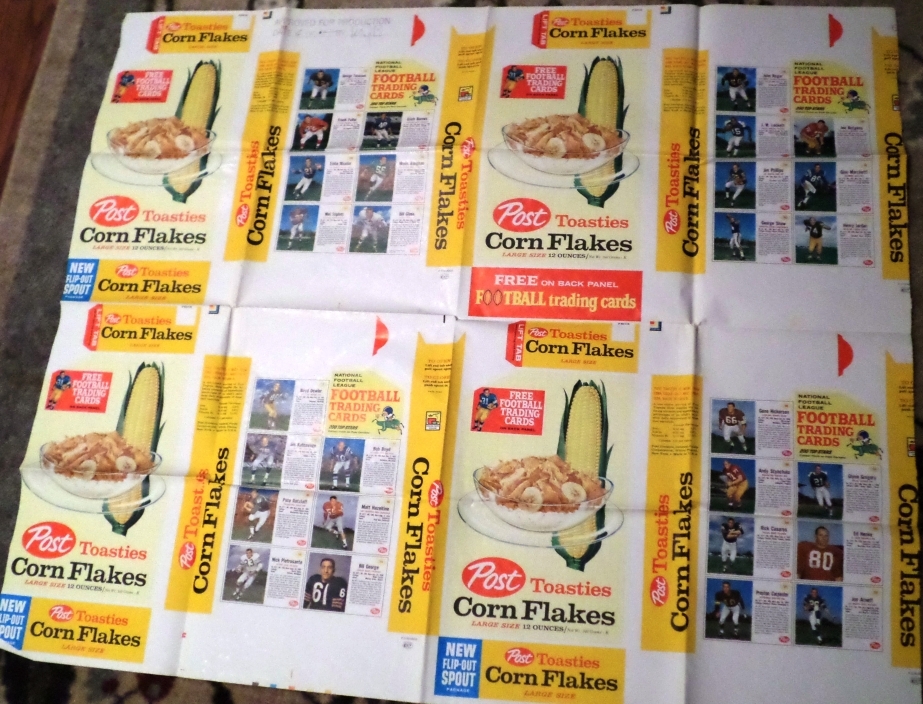 For instance, there were four 12 oz. Post Toasties flip-out spout back panels. The fronts, sides, tops and bottoms were the same for each of the four boxes. There were seven cards on each of the four back panels for a total of 28. In the photo at right, the top and bottom sides of the roll are the factory cut sides. Factory cut in this case would be defined as the edges that are created when the blank roll of paper is cut to width before it was run through the printing press. Color print marks are seen along the edge closest to the bottom. Shown this way, the paper was being fed moving either to the left or right, so the Post Toasties 12 oz. boxes were printed from the side. When this press sheet was cut from the roll in order to be approved, it was cut from the paper roll on the left and right sides of the picture.
For instance, there were four 12 oz. Post Toasties flip-out spout back panels. The fronts, sides, tops and bottoms were the same for each of the four boxes. There were seven cards on each of the four back panels for a total of 28. In the photo at right, the top and bottom sides of the roll are the factory cut sides. Factory cut in this case would be defined as the edges that are created when the blank roll of paper is cut to width before it was run through the printing press. Color print marks are seen along the edge closest to the bottom. Shown this way, the paper was being fed moving either to the left or right, so the Post Toasties 12 oz. boxes were printed from the side. When this press sheet was cut from the roll in order to be approved, it was cut from the paper roll on the left and right sides of the picture.
Rotogravure printing
With the cylinder etchings done and back at Post's carton and container plant in Battle Creek, Michigan, boxes were ready to be produced. Etchings on either cylinders or plates mounted on cylinders used acid to create small cells of different depths that held varying amounts of ink. The deeper the cell, the more ink that would be transferred to paper, allowing for color, shadow and highlight variations. A separate cylinder etching would be done for each of the five colors—cyan, magenta, yellow, black (CMYK) and a "key" color that correlated to the major color used on the cereal box. The letter K was used to designate black. For the 12 oz. Post Toasties flip-out spout press sheet shown here the key color was dark yellow as seen on the sides, tops and bottoms of each carton. There was a sixth "color" which was a clear lacquer coat applied last to add a layer of gloss.
The printing process involved large spools of 50,000 feet of paper and up to 43 inches wide being run through the five etched cylinders continuously with one color at a time being transferred to the paper. 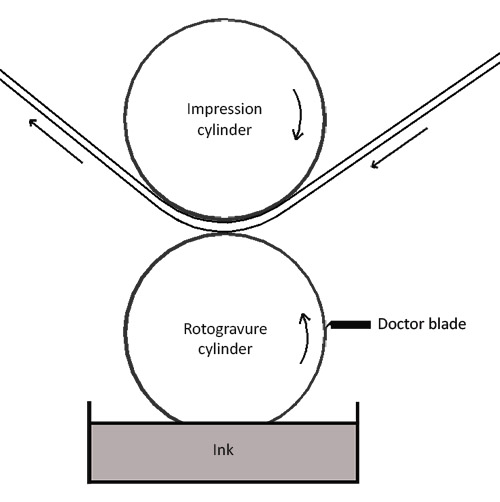 As each cylinder rotated, it picked up one of the ink colors placed in a well below it and then transferred the ink to the paper on the top side of the cylinder as the roll was pulled forward. The doctor blade ensured that the proper amount of ink was on the cylinder when it reached the paper. Between the individual cylinders of different ink colors, there was a quick drying step before the next color was applied over the previous color. Layers of color on top of each other resulted in different shades as well as shadows and highlights in the photo area. The biography areas used black and magenta ink, the football with the number used yellow and the red Post logo was magenta on top of white paper leaving the name visible by not placing any ink in the spots that formed the word "Post." The paper was spooled back up after receiving the lacquer coat and being sufficiently dried. This whole process took place a rate of approximately 600 feet per minute.
As each cylinder rotated, it picked up one of the ink colors placed in a well below it and then transferred the ink to the paper on the top side of the cylinder as the roll was pulled forward. The doctor blade ensured that the proper amount of ink was on the cylinder when it reached the paper. Between the individual cylinders of different ink colors, there was a quick drying step before the next color was applied over the previous color. Layers of color on top of each other resulted in different shades as well as shadows and highlights in the photo area. The biography areas used black and magenta ink, the football with the number used yellow and the red Post logo was magenta on top of white paper leaving the name visible by not placing any ink in the spots that formed the word "Post." The paper was spooled back up after receiving the lacquer coat and being sufficiently dried. This whole process took place a rate of approximately 600 feet per minute.
Prior to running tens of thousands of feet of printed boxes on paper, a press sheet as shown above would be taken from the start of the run. Color accuracy and registration would be checked before approval was given to proceed with the run. Proper color registration for the photo area requires each separate color to be placed exactly in position or the photo becomes blurry. Varying degrees of out of register cards are common.
Laminating boxes
The final step in producing cereal boxes consisted of laminating the previously printed paper rolls to cardboard stock and cutting each box to size. Lamination and cutting occurred at a rate of about 60 feet per minute—about one-tenth as fast as printing. The resulting flat boxes would be stacked and later formed and filled with product before shipment to stores. There are several examples of flat Post cereal boxes found within the collecting hobby today.
Double printed products
There are some interesting things to note about box production. As seen above in the press sheet example, all four panels of 12 oz. Post Toasties were printed on the same roll, two across and two back as it is termed. Looking at the press sheet photo, across is defined as the width of the paper roll. There was enough width on the roll for the Post Toasties 12 oz. boxes to print two boxes, thus two "across." As the roll was printed moving to the left, at least in the instance of our press sheet example, back panels 2 and 132 would have formed one row and panels 66 and 130 would have formed the second row. The term "back" is basically synonymous with what is normally thought of as a row. These four panels would continue to be printed over and over in this order as the paper was fed to the left and the printing cylinders rotated.
There were various across configurations used by Post to transfer the box images from the cylinders to the rolls of paper. Since the rolls were up to 43" wide, Post would be limited in how many box images could be printed across the width of the paper roll. Because each cereal box was a different size depending on the product it was housing, it required different across configurations in order to reduce paper waste and increase profit margins. For instance, 8 oz. Alpha-Bits boxes were run as three across and two back (two rows of three boxes), meaning that six boxes at a time were produced with each set of cylinder revolutions. As shown earlier on this website, there were only four different back panels of 8 oz. Alpha-Bits product. This means that two of the panels were double printed and two were single prints, for a total of six (three across times two back).
In over 25,000 collections of data on individual cards identifying cards sold by the cereal and panel they were on, it is clear that the two AB8 panels with cards that occur more often are panels 115 and 124. Panel 115 consists of 115 Stan Jones, 128 Lou Michaels, 143 Dick Moegle, 152 Jimmy Hill, 166 Lamar Lundy and 184 Fran Tarkenton. Panel 124 is star-laden with future Tarzan actor Mike Henry on the first card, Cowboys quarterback and future Monday Night Football analyst Don Meredith on 142, Post cereal promotion stars Jon Arnett (160) and Paul Hornung (6), College All-Star Tommy Mason (178) and Redskins lineman John Paluck on 195. The single print panels were numbers 12 and 22 and featured Bart Starr, Alex Karras, Doug Atkins and R.C. Owens along with eight others. Some of the sales data is skewed by star cards being sold more often than common cards due to the fact that sellers make more money for the same amount of time and effort. However, comparing common cards from all four panels, it is evident by consistent print marks that double printing of panels 115 and 124 actually occurred.
Of the 24 total cereal products used in the Post cereal football promotion, 17 of them are same brand/size multiple print panels. Please see the chart immediately below for a list of which ones are multiple prints and which ones are not. Technically, 15 oz. Oat Flakes would also have been the same as the SCCF10 boxes since they are duplicated back panels. However, as is covered on another page, Oat Flakes 15 oz. cards don't appear to have been sold in stores as only two panels and one hand-formed box with no adhesive on the back are known to exist.
The chart below shows how each cereal product most likely was printed. Longtime collector and retired Post cereal employee Bill Rothney provided the photo of the Post Toasties 12 oz. press sheet above along with information about the printing process including specifics about a few of the cereals' paper widths and across and back numbers. This provided a base of knowledge from which to work. Measurements of available boxes or panels were taken. Box measurements are close to being exact although the folds prohibit 100% accuracy. Flat box measurements are exact. Dimensions where panels were used to calculate box dimensions are best estimates. These dimensions were calculated based on the actual back panel dimension and correlating that with pixel dimensions from existing digital scans. Based on the extrapolated dimensions, across and back numbers were determined.
Based on box dimensions and double print deductions, it is believed that two rows (back) were etched into each cylinder. It is assumed that the cylinder circumference had a limit and 48" appears to be as large as Post would have needed for two row box print configurations. As the calculations were being done and various card versions determined, it became apparent that all of the boxes were configured as two back, with varying amounts going across depending on the size of the box.
The reality of several "versions" of each card from the same cereal product would be of interest to only the most ardent of master set collectors. Identifying each "version" requires, in some cases, up to a dozen high resolution images of the same card from a particular cereal product and a significant investment in time to definitively identify the differences. Cataloging them in a coherent fashion is yet another matter. But, guess what? The task of cataloging all the versions is essentially done as of March 2025. Interested master set collectors can anticipate either updated or additional master set pages in the future. A word of warning, however, the differences that determine each version are in most cases minute and collecting them will be the ultimate Post cereal football challenge.
| 1962 Post Cereal Football | |||||||||||||
| Box Print Layouts | |||||||||||||
| Brand | Oz. | Box width | Box height | # Across | # Back | Paper width | Cylinder circumference | Print direction | # Panels | Shelf talker # | Multiple print panels | Total panels | Version double prints |
| Post Toasties | 18 | 23-5/8" | 16-3/4" | 2 | 2 | 33-1/2" | 47-1/4" | Side | 2 | All double | 4 | 14 | |
| Post Toasties (Top) | 12 | 20-1/2" | 16-1/2" | 2 | 2 | 33" | 41" | Side | 4 | 132 (Red) | 4 | ||
| Post Toasties (Spout) | 12 | 20-1/2" | 16-1/2" | 2 | 2 | 33" | 41" | Side | 4 | 132 (Red) | 4 | ||
| Post Toasties | 8 | 18-1/2" | 12-1/2" | 3 | 2 | 37-1/2" | 37" | Side | 3 | 3 (Red) | All double | 6 | 15 |
| Bran Flakes | 16 | 19-1/4" | 13-1/4" | 3 | 2 | 39-3/4" | 38-1/2" | Side | 4 | 64, 134 | 6 | 14 | |
| Bran Flakes | 11 | 18-1/8" | 11-15/16" | 3 | 2 | 35-13/16" | 36-1/4" | Side | 4 | 123 (Blue) | 5, 123 | 6 | 12 |
| Grape Nuts Flakes | 16 | 20-7/8" | 13-7/8" | 3 | 2 | 41-5/8" | 41-3/4" | Side | 4 | 6, 70 | 6 | 14 | |
| Grape Nuts Flakes | 12 | 19" | 12-5/8" | 3 | 2 | 37-7/8" | 38" | Side | 6 | 200 (Blue) | 6 | ||
| Top 3 | 10 | 19" | 12-5/8" | 3 | 2 | 37-7/8" | 38" | Side | 6 | 200 (Blue) | 6 | ||
| Raisin Bran | 14 | 17-1/4" | 11-9/16" | 3 | 2 | 34-11/16" | 34-1/2" | Side | 4 | 120 (Yellow) | 8, 120 | 6 | 10 |
| Raisin Bran | 10 | 16-1/8" | 10-7/8" | 3 | 2 | 31-7/8" | 32-1/4" | Side | 4 | 25 (Yellow) | 25, 84 | 6 | 8 |
| Post Tens | 9½ | 16-3/8" | 5-3/8" | 7 | 2 | 37-5/8" | 32-3/4" | Side | 7 | All double | 14 | 21 | |
| Alpha-Bits | 13 | 20-1/4" | 15-7/8" | 2 | 2 | 31-3/4" | 40-1/2" | Side | 4 | 141 (Yellow) | 4 | ||
| Crispy Critters | 13 | 20-1/4" | 15-7/8" | 2 | 2 | 31-3/4" | 40-1/2" | Side | 4 | 141 (Red) | 4 | ||
| Alpha-Bits | 8 | 17-1/2" | 12-1/2" | 3 | 2 | 37-1/2" | 35" | Side | 4 | 124 (Yellow) | 115, 124 | 6 | 12 |
| Crispy Critters | 8 | 17-1/2" | 12-1/2" | 3 | 2 | 37-1/2" | 35" | Side | 4 | 124 (Red) | 115, 124 | 6 | 12 |
| Alpha-Bits | ¾ | 8-3/8" | 5-7/8" | 6 | 2 | 35-1/4" | 16-3/4" | Side | 6 | All double | 12 | 6 | |
| Sugar Crisp | 14 | 19" | 13-1/2" | 3 | 2 | 40-1/2" | 38" | Side | 3 | 55 (Yellow) | All double | 6 | 21 |
| Sugar Crisp | 9 | 18-3/16" | 11-15/16" | 3 | 2 | 35-13/16" | 36-3/8" | Side | 3 | 37 (Yellow) | All double | 6 | 18 |
| Sugar Coated Corn Flakes | 10 | 18-1/2" | 13-1/4" | 3 | 2 | 39-3/4" | 37" | Side | 4 | 15, 54 | 6 | 14 | |
| Rice Krinkles | 10 | 17" | 11-1/4" | 3 | 2 | 33-3/4" | 34" | Side | 6 | 16 (Blue) | 6 | ||
| Oat Flakes | 10 | 17" | 11-5/8" | 3 | 2 | 34-7/8" | 34" | Side | 4 | 129 (Yellow) | 129, 133 | 6 | 10 |
| Grape Nuts | 11 | 12-1/2" | 8-1/4" | 4 | 2 | 33" | 25" | Side | 2 | All quadruple | 8 | 12 | |
| Grape Nuts | 16 | 14-5/8" | 10" | 3 | 2 | 30" | 29-1/4" | Side | 3 | All double | 6 | 9 | |
| Total | 99 | 150 | 222 | ||||||||||
Box print layout table information
There are two types of multiple prints in the Post cereal football set: 1) two product double prints and 2) single product multiple prints.
Two product double prints are found on two different cereals where the back panels are the same. An example would be Crispy Critters and Alpha-Bits where both the 8 and 13 oz. sizes have the same back panel configurations. Other two product double prints are Grape Nuts Flakes 12 oz./Top 3 10 oz. and Post Toasties 12 oz. top flap/Post Toasties 12 oz. flip-out spout panels.
Multiple print panels are usually double prints of the same cereal product, i.e. Grape Nuts Flakes 16 oz. boxes with panels 6 and 70 being the double printed panels. However, Grape Nuts 11 oz. boxes are small enough that they were printed four across and two back. Since there are only two different panels, this means that there are four slightly different versions of panels 18 and 74. (Yes, that means there are four different GN11 versions of both Sam and Dave Baker!)
There are 99 different back panel configurations with 51 of those being multiple prints of the same product, totaling 150 separate panels. The 51 multiple print panels contain 222 cards, while the 99 different back panel configuration boxes add up to 528 cards bringing the grand total for all printed cards to 750.
It seems there should be a name for this 750 card set, since the set of 528 is called a Master Set. What could be more than a master set? How about Master Master Set for the set of 750?
Mechanical variations
There are two cards that Post "fixed" after the rotogravure cylinders were etched and printing of the boxes that contained those cards had already begun.
The Sugar Crisp 14 oz. card #55 Jim Martin was a same product double print that originally showed Martin with only the white of his eyes and no cornea or pupils. Whether it was between complete runs of boxes or Post shut down the presses is not known, but at some point somebody poked a dot in each of Martin's eyes on the black cylinder plate trying to give Jim more realistic looking eyes. That could have been done simply by making a small indentation in the correct place with a tool, perhaps an awl. Since the number 55 Martin card was a same product double print there were two images of this box etched into the rotogravure plates. Thus, both versions have slightly different positions for Martin's eye pupils as the "fix" wasn't located in exactly the same eyeball position on each of the images. Combine this with the fact that exact alignment of rotogravure cylinders caused registration issues, there are myriad positions for Martin's eyes. No matter how many different locations the pupils appear, there are actually only two versions of #55 Jim Martin with only the whites of his eyes and also only two versions with the dots intended to be pupils, for a total of four versions of that Sugar Crisp 14 oz. card.
Another "fix" also happened with the Alpha-Bits 13 oz. #172, Frank Ryan. That card is not a same product double print. The original version showed a white spot just above Ryan's left shoulder beside his neck and head. It occurred because the original etching process somehow missed that spot that should have contained blue sky. So Post fixed that area by scratching in the blue sky in the area above Frank's shoulder on the cyan cylinder.
There a are quite a few mechanical variations that occurred during printing when likely either a foreign substance or wear on the rotogravure plate caused a variation in printing. An example would be #157, Sonny Randle as a same product double print on 16 oz. Bran Flakes boxes. One of the two versions has a green line near Randle's feet, while the same version does not have the line. Evidently this occurred during a print run and was never corrected. Bran Flakes 16 oz. and Sugar Crisp 14 oz. cards appear to have the most cards with these sorts of mechanical variations.
How many cards in a Master Master Set now?
There were 750 different card images in total on the 1962 Post cereal football rotogravure plates. There were more cards with mechanical issues as just described. It becomes a matter of personal preference how many mechanical variations anyone may want to add on to the Master Master Set. Collectors seem to enjoy doing their own thing, but 750 is a complete Master Master Set.
Color variations
There are color variations on double printed same product cards that are the result of etchings on the same cylinder that appear to have different depths which resulted in different color shades. Some Sugar Crisp 14 oz. and Grape Nuts 16 oz. cards show consistent color variations that are consistently beyond what would be expected from differences in shades of ink placed into vats during print runs. Ink color differences did happen frequently. Assuming, for example, that because a #142 Don Meredith 14 oz. Sugar Crisp card has one version with a purplish jersey and another that is strictly blue defines either as a particular version can be an errant assumption. Color variations can be used to key in on a card, but the telltale sign is the tiny print mark(s) that definitively identify the correct version.
Shelf Talkers Collector and avid Post cereal researcher, Dave Worley, notes that boxes with advertising text "FREE on back panel FOOTBALL trading cards" were known as "shelf talkers." Shown below are 8 oz. Alpha-Bits back panels with the bottom flap attached. The blue flap was the regular bottom flap color and the yellow flap was the shelf talker. The purpose of the bottom flap color difference on the shelf talker box was that it drew attention to that box when placed either flat or on its side with the bottom flap exposed. It highlighted the fact that there were football cards on the back of the boxes in this group. As previously discussed on this page, there were four different 8 oz. Alpha-Bits back panels, but six were printed each time the cylinder made one revolution. As mentioned above, this means that there are single prints of panels 12 and 22 and double prints of panels 115 and 124. Essentially, the amount of #12 Bart Starr cards produced was half that of #115 Stan Jones as well as all the corresponding cards on the double printed Alpha-Bits 8 oz. panels. This means there was one etched image of panels 12 and 22 and two etched images of panels 115 and 124. There are no two etched images exactly alike. Although the photo cropping will be exactly the same, there will be some minute variations such as blue, red or black dots appearing on one card and not the other. There is a difficulty with identification in that registry issues will sometimes disguise the telltale print marks. It is also usually the case that coloring will be slightly different on the panels with the same cards on the back as is the case with the two panels shown here. Take a look at the cards on the same panels with two different bottom flaps. The colors are slightly different. Was it because of the bottom flap color or simply because of ink intensity differences when the ink wells were refilled? Or because the etched images are distinct? There are quite a few individual cut cards available for viewing with these color variations. It would appear it is possible to separate the differences of the two. Was this 100% consistent so that we can definitively label a card as coming from the blue or yellow bottom flapped box? After looking at all 222 same product double printed cards, it is evident that there are, indeed some cards that generally exhibit consistently differing color characteristics. But there were enough shade differences in the ink used at the time of printing back in 1962, that basing a version on color alone isn't sufficient. The bottom line is that only consistent differences in the various small print marks on the separate versions of each double printed card can be trusted as positive identification. The Alpha-Bits 8 oz. boxes are not the only ones with shelf talker and regular bottoms on boxes with the same panel. One back panel of each 11 oz. Bran Flakes and 9 oz. Sugar Crisp was also printed this way. While the blue flap on the Bran Flakes 11 oz. shelf talker shows only a sliver here, it is apparent.
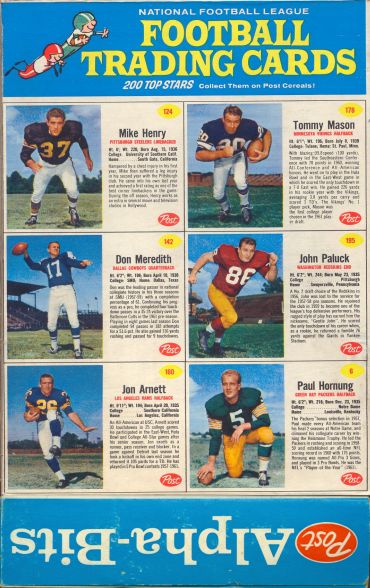
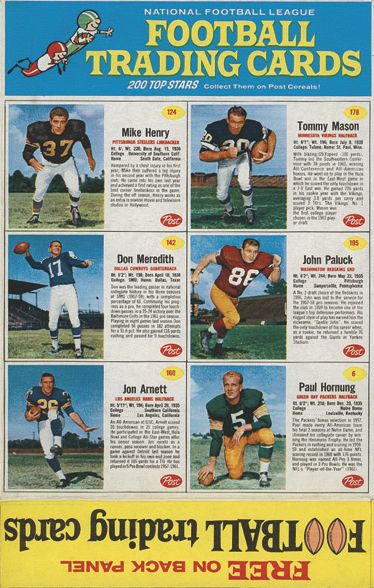
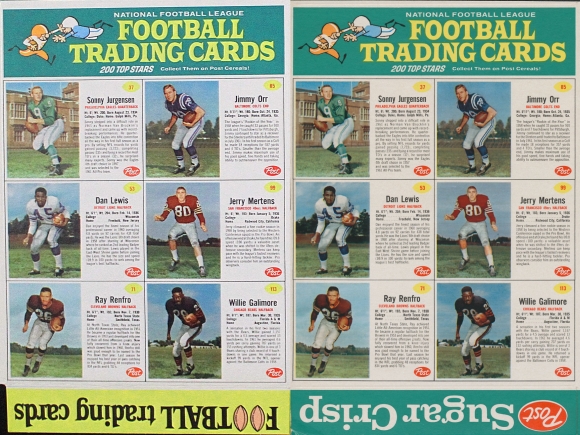
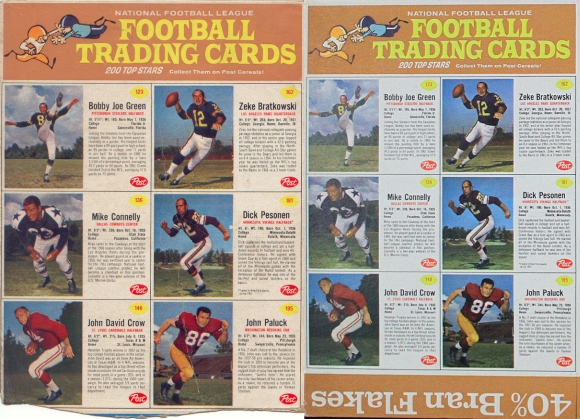
Alpha-Bits 8 oz., both Sugar Crisp 9 and 14 oz., and 11 oz. Bran Flakes are the only products that images have been found with the same panel on regular and shelf talker boxes. Studying the chart above, it would not be difficult to believe that other cereals such as 8 oz. Post Toasties, 10 oz. Raisin Bran, 13 oz. Alpha-Bits and Crispy Critters, and 8 oz. Crispy Critters may also have a shelf talker and a regular bottom flap box.
Are we there yet?
Back to the original question at the top of this page—why are some cards that are on the same short print boxes scarcer than others on the same two boxes? The answer is that there were same product double prints for many of the back panels that came about as a result of Post's assignment of panels for each cereal product's rotogravure plates based on box sizes. It is interesting that, for the most part, the card market has traditionally shown this for decades. Examples of cards that are paired on like products demonstrate the value of single printing versus double printing:
- Brookshier's was not, the production numbers of OF10 versus SCCF10 make Tubbs' card more difficult to collect.
The economics of supply and demand have regulated prices even though collectors may not have recognized the cause. There really was a reasonable explanation all along.
*This page was updated in March 2025 to provide new information about multiple printed panels on the same cereal product. Should the reader wish to see the original content, please click here. The page will open in a new tab.

